Affiliate disclosure: This post may contain affiliate links. Please see our Privacy Policy.
Few houseplants can match Tulsi for both beauty and fragrance. Tulsi, also known as holy basil or sacred basil, is a perennial in tropical and subtropical regions, but it can be grown indoors year round regardless of your climate.
Each year we plant a large patch in our vegetable garden and harvest well before harvest first frost to dry for winter teas. Unlike other annual basil varieties, which bloom and then become bitter, tulsi is known to bloom and keep blooming, providing forage for the bees and fragrance for your garden.
If brought indoors for the winter, tulsi will keep right on blooming and liven up any room with its sweet fragrance.
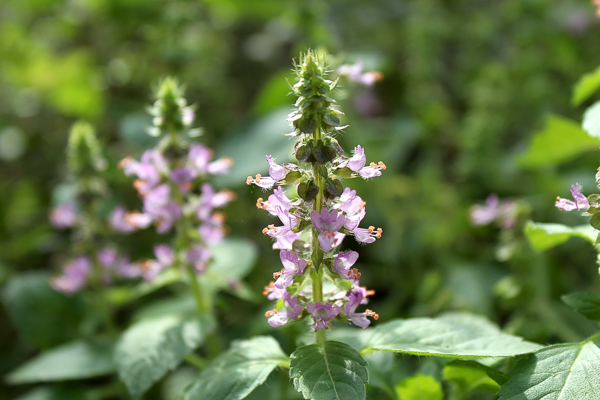
Growing Tulsi From Seed
Tulsi seeds should be started indoors 6 to 12 weeks before the last frost. Since tulsi is a tropical plant, it requires warm temperatures to germinate and should be kept in a place that’s at least 70 degrees. If your house is particularly cool, consider using a seedling heat mat to warm soil temperatures.
The soil should be kept continuously moist, but not soggy. Seeds will germinate about 3 weeks after planting.
The plants are very frost sensitive, and should not be moved outdoors until several weeks after the last frost date. Even then, remember to give them an acclimation period to harden off by bringing them indoors into a sheltered place at night for a week or so before permanently planting outdoors. Cold frames are also a good option.
If you’re growing tulsi indoors, be sure that the plant has ample sunlight in a south-facing window for at least 4-6 hours of direct sunlight per day.
Growing Tulsi From Cuttings
Tulsi also readily grows from cuttings. Use a pair of sharp garden shears and cut a tulsi stem from an established plant. Remove all the flowers and most the leaves. Place the cutting in a glass of water on a sunny windowsill. Make sure it’s kept continually warm, and change the water every few days to avoid mold or stagnation. The cutting should take root in a few weeks.
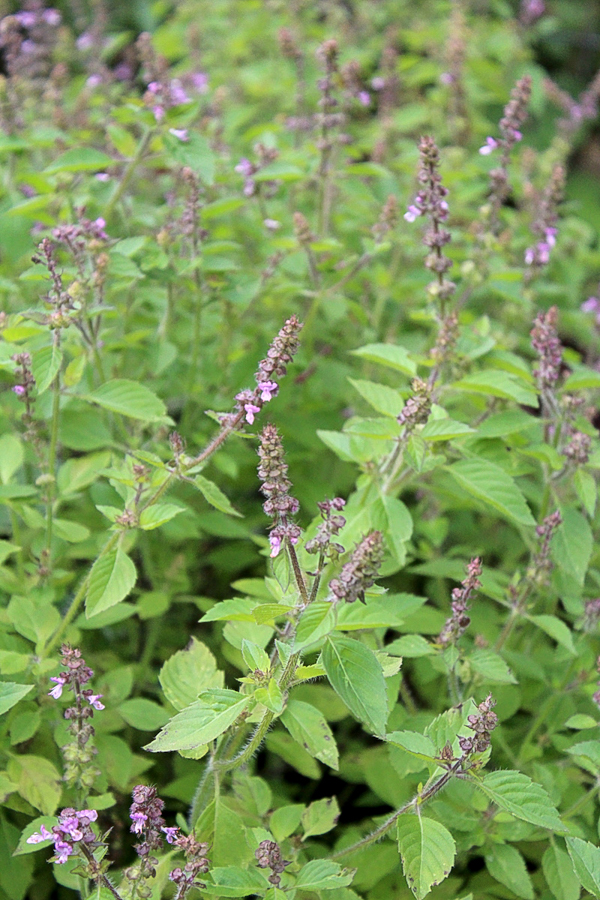
Tulsi Plant Care
Once your tulsi plant is established, it needs continuously warm temperatures to thrive. Tulsi is hardy in zones 10 and 11, and can be grown year-round in the very hottest parts of the US that never see a frost. For the rest of us, tulsi can be grown as an annual outdoors, or as a perennial houseplant.
Hardiness – Tulsi is hardy to zone 10, and cannot handle any frost. Ideally, temperatures would remain above 50 degrees for optimal growth.
Sunlight – In ideal conditions, tulsi requires at least 6 hours of sunlight per day. It can survive part sunlight conditions, with as little as 4 hours of direct sunlight per day.
Soil – Most balanced potting mixes are appropriate for growing indoors.
Fertilizer – Tulsi requires fertile soils to thrive, especially if you’re regularly harvesting leaves for tea and seasoning. Be sure to supplement with compost to ensure adequate fertility. To the soil with an inch of rich compost every 6 months. The best fertilizer for tulsi plants is a balanced 10-10-10 liquid fertilizer and can be applied every few months for indoor plants.
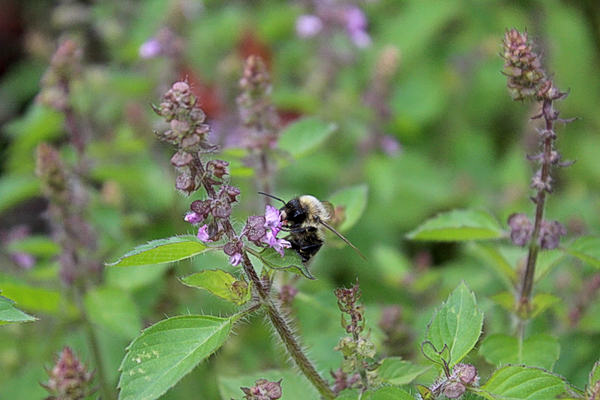
When to Harvest Tulsi
How long does it take to grow tulsi? Since tulsi is a perennial, it’s best to continuously harvest small amounts of the herb to allow for continued growth.
You can begin to harvest tulsi once the plant reaches about a foot in height. Pinch back the growing tips to help encourage a bushy plant habit, which will increase yields. Tulsi plants should be ready for harvest about 40 days after germination and do best with sparse periodic harvests. If harvested gently, by single leaves or branches, a tulsi plant can continue to produce for several years.
In India, tulsi bushes can reach 4 to 5 feet tall in the intense summer heat, but indoors or in more temperate climates, they stay small and bushy, growing no bigger than 1 to 2 feet.
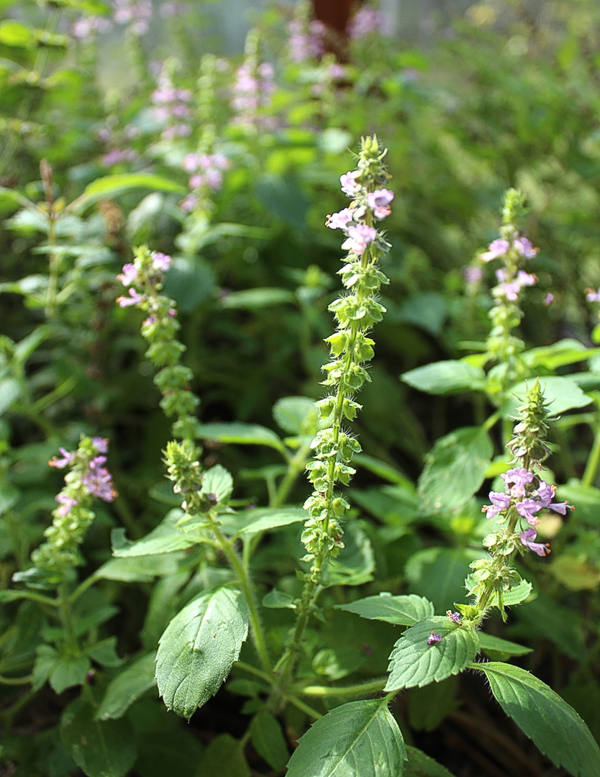
Types of Holy Basil Plants
There are a surprising number of holy basil varieties, each with their own distinctive characteristics. Since tulsi has been grown in India for medicine for thousands of years, there has been plenty of time for unique cultivars to develop. The three main varieties include:
Rama Tulsi
This variety has light green leaves and purple flowers and smells strongly of cloves. The flavor of this variety is mellower than others, but even though it has stronger smelling leaves. The mild flavor makes it versatile as an after meal tea, and it’s used to promote healthy digestion. Rama tulsi is also known as green leaf tulsi.
Krishna Tulsi
A purple leafed variety, krishna tulsi a rarer variety of holy basil. It grows more slowly, and it’s thought that the slow growth contributes to the accumulation of stronger, spicier and more pungent flavors. The flavor is peppery and clove like, and the warm spicy tea it produces is used to treat respiratory infections among other things. Krishna tulsi is also known as Shyama tulsi and purple leaf tulsi.
Vana Tulsi
Considered the best tasting, Vana tulsi is actually a bit harder to find. The leaves come in two tones, with the upper leaves light green and the lower leaves on the plant coming in darker green. The flavor is more lemony, unlike the peppery and clove flavored other varieties.
How to Use Tulsi
The most common way to use tulsi is in a tea. The tea has a natural sweet flavor that reminds me of lemon balm with a slight hint of clove. A brand called Organic India sells a number of tulsi tea blends, each mixed to bring out different medicinal qualities of the tulsi plant.
Make tulsi tea by steeping about a tablespoon of the herb in 1 cup of near boiling water for 15 minutes. Bring the water to a boil and then allow it to cool for a few seconds before pouring over the tulsi tea leaves. Boiling water will drive off the volatile compounds and you won’t get as much flavor in your final tea. Strain the tea and enjoy plain or with a sweetener. Honey works particularly well if you’re taking tulsi for respiratory issues.
Beyond tea, tulsi is traditionally used as a spice and it’s sprinkled on foods to enhance the flavor in much the same way that pepper or Italian basil is used.
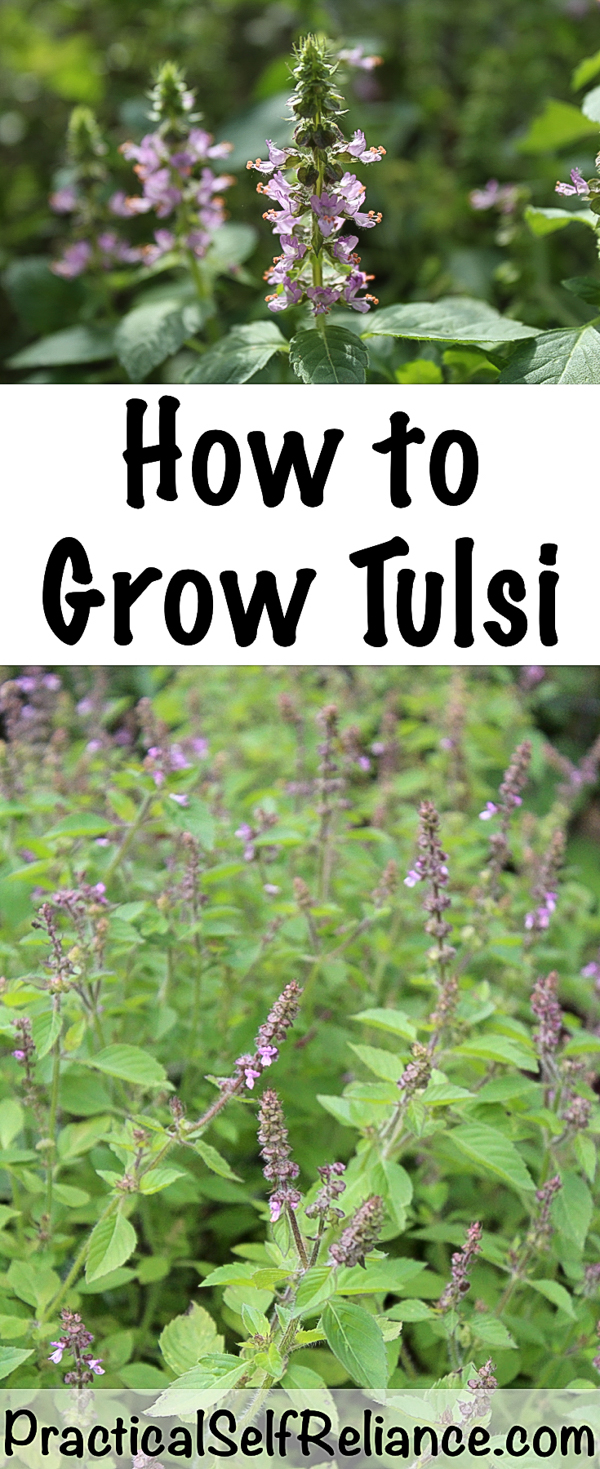
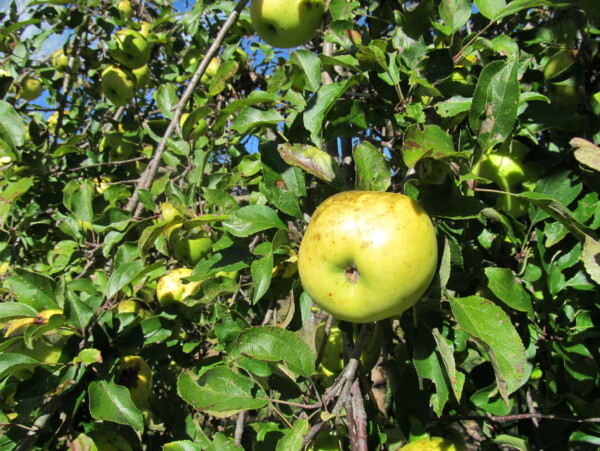



I did a lot of research and for a Tulsi 26 inches tall and 25 inches wide I used a 100 watt 350 micromole LED light and keep her 24 inches from her dome and the light penetrates to the lower leaves. They are developing better quality LED plant lights now at a cheaper price. I bought a 400 watt LED and my electric bill was too high. Depending on the size and number of your Tulsi plants you need to give light to will determine what size lamp you need. How close you keep Tulsi to the light is determined by if you want to germinate the seeds 24 to 30 inches; for seedlings 24 inches; for the vegetative stage 18 to 24 inches; for the flowering stage 18 inches. It’s not really too significant about how high your wattage is. It’s the micromole value. I would talk to an experienced horticulturalist for good advice. All the terms can be complicated to understand. I don’t advise buying off the internet unless they are the manufacturer. I paid only $16 for the above light in China, You do not need 12 to 16 hours for Tulsi to be under a plant light unless she is without any sunlight whatsoever. I give her 4 to 6 hours because I have only indirect sunlight on my balcony 5 months out of the year
I tried to grow Tulsa inside the apt. Its been three weeks already, nothing us happening,
Do you have a whole plant or are you trying to start it from seed?
Some information about growing Tulsi under lights indoors in UK during winter would be helpful.
I will have this problem next winter. I live in centre france. So I have browsed around and found LED horticulture lamps. They are not very expensive. I will start with 2 for 1 Tulsi, 3 citrusplants, 1 Begonia and maybe 1 or 2 more Herbalife plants. I will put the plants together on one table in matching pots for hubby’s eyes. I think that it will be much better than last winters.
You would simply follow all of the recommendations in the article for growing tusli. If you plan to use a grow light, just be sure to give them 4 to 6 hours each day.
Thanks for the great info! I have a question that hopefully you can help me with. I receieved a Krishna Tulsi from a family member when it was very small and it has grown to about 2ft at this point. However it has not branched outward and I realize this is because I have not been pruning it. It is just one long stem and starting to droop at the top. What would be the best way to prun it to promote outward growth without killing it? I’m afraid if I prun it at the top now, it will become even more top heavy and continue to fall or that I could kill it all together!
Any suggestions?
Generally just removing the blooms will encourage it to bush out more, especially when its’s young. Try that and see how it goes.
If Tulsi is getting too tall and leggy where she is falling over, it might be because she is not getting enough sunlight. I recommend a plant light if you can’t give her 4 to 6 hours of sunlight a day. I only get good sunlight for 7 months out of the year; therefore I turned to using a plant light . Also it is good that you turn Tulsi to face the sun if part of her remains in shade throughout the day. It is a bit complicated to determine what kind of plant light you need and the specifications required. Don’t think that the higher wattage you get the better. You will have a huge electric bill. I would consult the manufacturer to advise you. As long as your plant light penetrates the canopy and reaches your lower leaves it will be good. I recommend a full spectrum LED plant light. It’s a little difficult to understand if you research online about all the light specifications. Also, when your Tulsi reaches 8 inches in height you must cut her main branch back to where new leaves are beginning to sprout. That way you will allow her to grow out and bushier and not get too tall with a sparse amount of dense foliage. The rule of the thumb is when you trim her down , she will then branch out instead of only up
All Plants Images and Information very nice i like it all plant so beautiful. Beyond tea, tulsi is traditionally used as a spice and it’s sprinkled on foods to enhance the flavor in much the same way that pepper or Italian basil is used. Very Nice Part And Picture.
Whenever it is mentioned something regarding the temperature,it is not clearly stated whether it is in celcius or fahrenhiet scale??????
Fahrenheit.
How can I grow Tulsi inside house with very less sunlight?
I stay in Seattle so I don’t think sunlight will always be there.
Can I use UV lights or something?
In that case, yes, I’d suggest adding grow lights.
I use a 600 watt full spectrum LED plant light for 3 Tulsi’s, How many hours a day do I need to have it on. All over internet they say 12 to 16 hours. That’s a big electric bill. Please advise. Thank you for your support
Sincerely.
David
Honestly, I don’t use lights at all, our solar electric system really couldn’t support it, so I don’t have any solid advice for you in terms of grow lights.
Thanks so much for your informative and helpful post, Ashley. With harvesting, you mentioned gently harvesting by single leaf or branches. Do you recommend one over the other? Single leaf would obviously be more gentle than branch harvesting. If so, how do you recommend drying for tea when harvesting by picking single leaf?
Also, do they have a soil moisture preference? Moist? Prefer to be completely dry before watering? Other preference?
Thanks so much!
When we make tea during the summer months, we harvest by single leaf and just make it fresh. You can lay the leaves on a drying screen and dry them that way too. At the end of the season, we cut the plants off at ground level (since they won’t overwinter here in zone 4) and tie them in bundles to hang to dry.
Ours have always grown well in relatively dry soil (for Vermont, things are wet here!). Our greenhouse soil was peat/sand/compost and very well-drained, and they did well even when it dried out completely on occasion. In the garden, they’ve done well in the ground, which has clay soil or in raised planters with that same peat/sand/compost mix. They seem to be pretty adaptable, but they do better than most things with low water.
Thank you for sharing. This is great information. Do you harvest and hang to dry for the tea, or is tea made with fresh harvested leaves?
Yes, I harvest them and hang the bunches to dry for tea. You can also make a tea with the fresh leaves right out of the garden, and in the summertime, it makes a great fresh sun tea.
Very detailed information. Liked it
The challenge I am facing is to find a ready authetic Tulsi ready plants of each of above three… the holy green, purple (krishna), rama and vana kinds
If any one have an idea if I can get the ready plants then please share the details. I tried sowing seeds of holy basil, but either they never germinate or die after few weeks.
I am located in California (hardness zone 9)
Thanks
Deepak
I’m sorry I don’t know much about growing in zone 9. We’re in zone 4, which has very different seasons. If you’re looking for a good seed source, strictly medicinal seeds has an excellent selection by variety.
Namaste Deepak’s, I have seeds for Rama & Krishna that generally germinate as I have shared with much success, I will be happy to share if you like, I am hesitant sharing a plant as tulsi is very sensitive to being moved around. From my experience, seeds from India will germinate and than not survive in case your seeds are from India which you maybe experiencing.
Sorry JR, seeing your comment very late; Thanks for offering to share seeds. I will like to get those. Let me know your email contact and i will message you
Thanks
Hi JR and Deepak, Did you ever get connected regarding seed sharing? I would very much appreciate being able to get a few seeds of the different varieties as well. Thank you very much.
Would you be able to share the Rama and Krishna seeds still?
Hello,
When we grow Tulasi from cutting, can we leave it in the water without transferring to soil? like some plants that grow in water?
Yes, that should work pretty well so long as you keep the water clean. I haven’t tried to culture one exclusively in water, but I believe it would work.
I plan to try growing some Kapoor tulsi in leca; in my indoor cabinet greenhouse; as long as I add fertilizer to the water, it should work well. Any thoughts or experience on this growing method?
I am not familiar with this particular method but as long as all of the plants needs are met you should be fine.
Thank you very much for very informative piece of writing for growing Tulsi indoor or out side. I did know about Ram Tulsi and Krishna/Shyam(black) Tulsi but not the Vana Tulsi.
Appreciate the detailed inputs Ashely. My Tulsi didnt survive this canadian winter. I will try your ideas next summer.
Many Thanks!
Thank you for detail information …
Thanks for this wonderful and insightful posting
Excellent detailed instructions- thanks